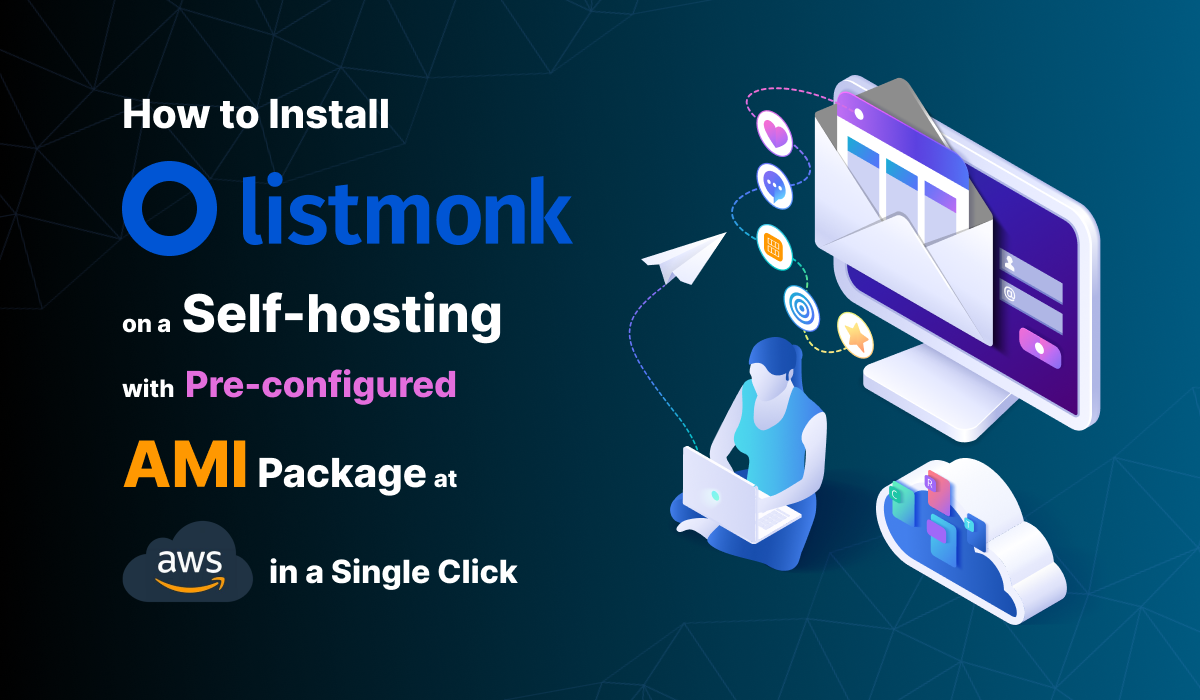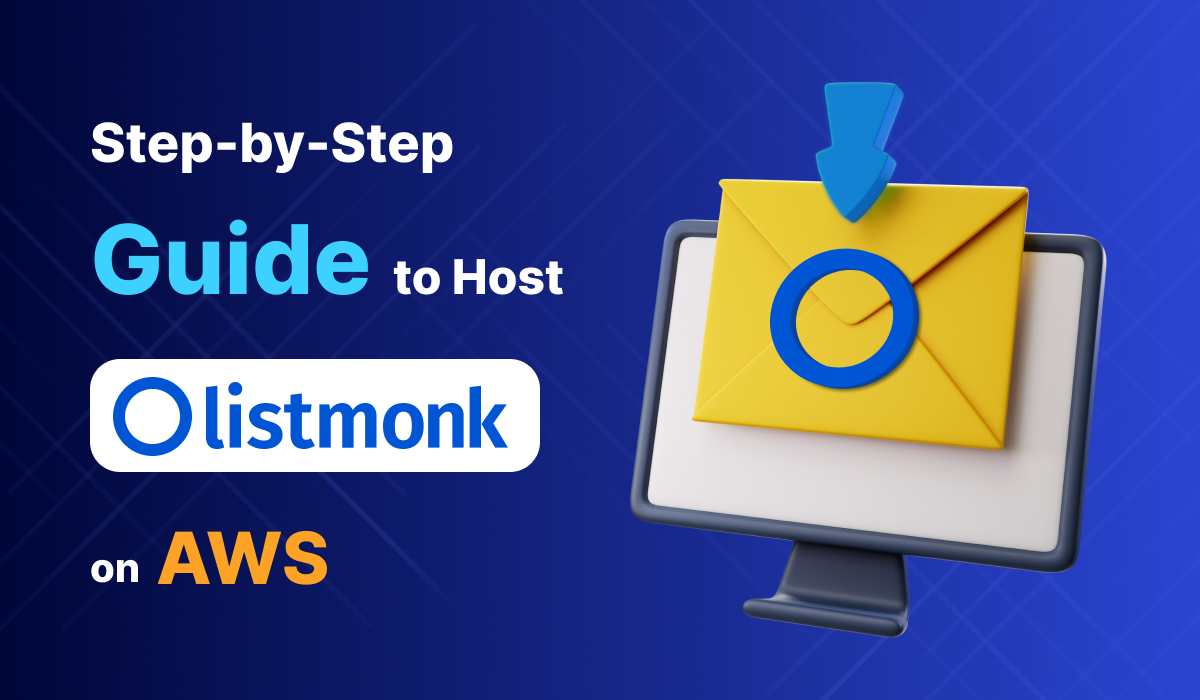How to Setup Listmonk on AWS with Pre-Configured AMI - Commercial Support for Listmonk

What is Listmonk?
In today's digital landscape, effective communication remains paramount. Enter Listmonk, a revolutionary, open-source mailing solution that has swiftly become the go-to for professionals and businesses alike. Listmonk not only refines the art of email campaigning but also reimagines it. Built on a robust Go backend, it promises speed, agility, and unparalleled user experience. Dive into its suite of features, from real-time analytics to customizable templates, and it's evident: this open-source mailing powerhouse is not just a tool, but a revolution. Whether you're a seasoned developer aiming to optimize API integrations or a startup seeking to captivate audiences with engaging newsletters, Listmonk has got your back. As we journey ahead in this article, we'll unveil the intricacies, advantages, and sheer brilliance that is Listmonk, all while ensuring you're equipped to make the most of this modern marvel in the realm of email campaigns.
The Self-Hosting Advantage
But what truly sets Listmonk apart? It's the freedom of self-hosting. In an age where data privacy and control are at the forefront of every business discussion, self-hosted applications like Listmonk empower users. By hosting on one's own infrastructure, users gain greater control over data, ensure better security, and enjoy the flexibility to customize the application to their heart's content, free from third-party restrictions.
Listmonk - Complete Developer Guide

Self-hosted Listmonk vs Traditional Email Marketing Platforms
When it comes to managing email marketing campaigns, the choices are vast. Yet, with the advent of powerful open-source tools like Listmonk, the discussion often leans towards a critical decision: self-hosting or relying on SaaS platforms. By hosting Listmonk on AWS, you're at the helm of your mailing infrastructure, but with traditional platforms, there's an ease of off-the-shelf functionalities. Here, we break down the pros and cons to give you a clearer picture.
Pros and Cons of Self-hosted Listmonk on AWS vs Traditional SaaS Platforms
Both self-hosting Listmonk on AWS and opting for traditional SaaS email marketing platforms have their merits. Your choice will hinge on your organization's priorities, technical capabilities, and long-term goals. Whether it's the autonomy and flexibility of Listmonk or the ready-to-use nature of SaaS platforms, it's essential to pick the one that aligns best with your objectives.
What is Meerix's Pre-configured Listmonk AMI Package?
Meerix's Pre-configured One-click Listmonk setup AMI provides an all-in-one solution for those looking to swiftly deploy Listmonk in the AWS ecosystem. At its core, the AMI is an embodiment of convenience, eliminating the need for the traditional multi-step setup process. With this AMI, users are presented with a pre-installed version of Listmonk, accompanied by the essential configurations tailored for AWS. This ensures an immediate and seamless deployment, allowing businesses to focus more on their email marketing strategies rather than the intricacies of setup.
The package isn't just about speed; it's also about optimization and security. Meerix has engineered the AMI to operate efficiently within the AWS infrastructure, encompassing settings designed for load balancing, and backups. The AMI's integration with AWS also means it's fortified with robust security measures, from firewall configurations to secure access controls.
Moreover, users can expect to deploy the latest stable version of Listmonk, ensuring they have access to the most recent features and vital security patches. Lastly, the potential availability of dedicated support and comprehensive documentation amplifies the value of Meerix's offering, making it an indispensable tool for anyone eager to harness the power of Listmonk on AWS.
Benefits of Using Pre-configured AMI for Listmonk Installation
In the contemporary digital landscape, it's not just about having the right tools, but also about ensuring their deployment is smooth, efficient, and value-driven. Leveraging a Pre-configured AMI for your Listmonk installation comes with a plethora of benefits that streamline operations, ensure cost efficiency, and maintain high standards of reliability and security.
1. One-Click Deployment: The name says it all. Bypass complicated setup procedures and kickstart your Listmonk experience instantly.
2. Fully Pre-configured AMI: Eliminate guesswork with an AMI tailored to integrate seamlessly with AWS.
3. Low-Cost SaaS SME Solution: Ideal for small to medium enterprises looking for affordability without compromising on quality.
4. Unbeatable Pricing: Attain a premium service at costs slashed by up to 75%. Truly a game-changer for businesses on a budget.
5. Hassle-Free Experience: Shed the technical burdens and dive straight into crafting your email marketing strategies.
6. Proven Reliability: Our solution undergoes rigorous testing, ensuring you're getting a dependable, trustworthy tool.
7. Pay-Per-Hour Flexibility: Embrace a pricing model that values efficiency. Pay only for the hours you utilize, maximizing cost benefits.
8. Amazon-Backed Security: Sleep easy knowing your system is safeguarded by industry-standard security measures courtesy of Amazon.
9. User-Centric Data Control: Be the master of your domain, having granular control over every byte of your data.
10. Automatic Safety Nets: Our AMI comes equipped with backup systems, safeguarding you from unexpected data loss scenarios.
11. Integrated Tools: Everything you need, all under one roof. This suite is designed to supercharge your productivity.
12. Transparent Pricing: Clear, upfront, and honest. Our pricing model ensures there are no unwelcome surprises.
13. Regular Updates: Technology evolves rapidly. Stay updated with regular feature enhancements and the most recent security patches.
14. Detailed Analytics and Reporting: For the data-driven marketer. Delve deep into metrics, understand your audience better, and refine your strategies with Listmonk's comprehensive analytics.
15. GDPR Security with Self-Hosting for Listmonk
- Data Privacy Assurance: Deploying Listmonk via Meetrix's AMI on AWS allows organizations to maintain full control over their mailing lists and subscriber data. This autonomy is crucial for complying with GDPR, as it ensures that data handling processes meet the stringent requirements set out by the regulation.
- Secure Data Management: The self-hosted setup of Listmonk facilitated by Meetrix's AMI incorporates advanced security protocols to protect subscriber information. By hosting on AWS, organizations benefit from robust encryption, network security, and access controls, significantly mitigating risks associated with data breaches and unauthorized access.
16. Commercial Support for Listmonk
- Customized Implementation Guidance: Meetrix provides commercial support that includes customized advice on implementing Listmonk in a manner that aligns with an organization's specific data protection policies and GDPR compliance. This includes setting up secure data collection forms, managing consent logs, and ensuring data is processed lawfully.
- API Integration and Technical Support: With Meetrix's commercial support, businesses gain access to technical assistance for API integration, allowing for the smooth incorporation of Listmonk into existing systems. This includes help with automating mailing list management, integrating with CRM systems, and optimizing email delivery performance.
- GDPR Compliance Strategy: Part of the commercial support offered by Meetrix includes consulting on GDPR compliance strategies specific to email marketing and subscriber data management with Listmonk. Organizations are guided on best practices for subscriber consent, data minimization, and secure data storage.
- Dedicated Support for Troubleshooting and Updates: Meetrix ensures that clients have dedicated support for addressing any technical issues that may arise with their Listmonk deployment. This includes troubleshooting, updates, and patches to keep the mailing system secure, efficient, and compliant with evolving GDPR guidelines.
Prerequisites for Using Pre-configured AMI for Listmonk on AWS
Before we start, ensure you have the following
1. An active AWS account. If not, sign up here.
2. AWS Basics
- Knowledge of launching and managing EC2 instances.
- Basic understanding of AWS VPC, Subnets, and security protocols.
- Familiarity with AWS storage solutions like EBS.
3. Listmonk Know-how,
- Awareness of Listmonk's main features.
- A quick look at Listmonk's documentation for any advanced configurations or feature insights.
What is an AMI?
An Amazon Machine Image (AMI) is a snapshot of a configured virtual machine. In simple terms, think of it as a 'template' that contains the information required to launch an instance. This includes the operating system (OS), the software on that system, and any additional settings.
Steps to Locate the Pre-configured Listmonk AMI
1. Navigating the AWS Marketplace
- Log into your AWS Management Console.
- Click on "Services" and select "EC2" to access the EC2 Dashboard.
- On the left sidebar, under "Create Instance," choose "AWS Marketplace."
2. Searching for the Listmonk AMI Package
- In the AWS Marketplace search bar, type "Listmonk Pre-configured AMI" or "Listmonk by Meerix."
- Browse the search results to locate Meerix's Pre-configured Listmonk AMI.
- Ensure you verify the vendor name and details before proceeding.
- With the AMI located, you're one step closer to launching your instance. Remember, using a pre-configured AMI like this one makes your Listmonk deployment process significantly more streamlined.
3. Creating a CloudFormation Stack
- Prepare: Ensure the template is ready > Click "Next".
- Specify: Input details like email, domain name, instance type, passwords, etc. > Click "Next".
- Configure Failure Options: Choose "Roll back all" > Click "Next".
- Review: Verify details > Acknowledge AWS IAM resources creation > Submit.
4. Update DNS
- Copy the "PublicIp" from the Outputs tab.
- In AWS Route 53 > Select your domain > Edit record > Paste the IP.
5. Accessing Listmonk
- Use the "DashboardUrl" from Outputs.
- Log in with "listmonk" and the password set earlier.
6. Setting Up Gmail SMTP
- Password Retrieval: Enable 2-step verification in Google account > Obtain App password.
- SMTP Test: In Listmonk settings, input Gmail details and send a test email.
7. Manual SSL Generation
- Only needed if Route53 hosting fails. Follow the instructions in "Update DNS", then log into the server and generate SSL.
8. Shutting Down & Removing Listmonk
- Stop the instance via EC2 or delete the CloudFormation Stack.
9. Support & API
- Contact: support@meetrix.io for technical assistance.
- Utilize Listmonk’s HTTP APIs for additional functionalities.
Post-installation Steps for Listmonk on AWS
1. Initial Setup
- SMTP Configuration: Navigate to the Listmonk settings. Set up your SMTP details to handle email operations.
- Admin Credentials: Ensure you have set strong and unique passwords for both the Listmonk web interface and associated databases.
- Dashboard Access: Remember to frequently check the "DashboardUrl" from Outputs for any essential notifications or updates.
2. Security Considerations
- Security Groups: Ensure that only necessary ports are open. Commonly, ports for HTTP/HTTPS and SSH should be accessible.
- IAM Roles: Assign only the required permissions. Avoid using root or overly permissive roles.
- SSL Certificates: If you're not using Route53 or if the automatic setup fails, remember to set up SSL manually to encrypt web traffic.
3. Regular Maintenance:
- Backups: Utilize the auto-push feature to regularly back up PostgreSQL data to S3. Ensure the S3 bucket has the correct permissions and is not publicly accessible.
- Updates: Periodically check for software updates for Listmonk. This ensures you're protected from known vulnerabilities and benefit from the latest features.
- Operational Checks: Regularly monitor the health of the AWS instance. Use AWS CloudWatch or similar tools to get insights into the performance and potential issues.
Stay vigilant and ensure regular maintenance for the smooth operation of your Listmonk instance on AWS. If you need further assistance or more in-depth guidance, consider reaching out to AWS or Listmonk documentation.
Refer: Meetrix’s Full Installation Guide
Integrating Listmonk with AWS Services
1. S3 Backups: Automate Listmonk's PostgreSQL database backups to an encrypted S3 bucket. Periodically test backups for assured data integrity.
2. Lambda and Listmonk API
Combining the power of AWS Lambda with Listmonk API can allow you to automate a plethora of tasks and integrate various services seamlessly.
- Automation: Use Lambda functions to automate tasks like subscriber management, campaign launches, or report generation in Listmonk.
- Set up triggers based on specific events or schedules.
- Integration: Connect other AWS services with Listmonk. For instance, whenever a new user signs up on your website (hosted on AWS), use Lambda to automatically add them to a Listmonk subscriber list.
3. Using RDS for PostgreSQL: Consider AWS RDS for PostgreSQL over Listmonk's default setup. It offers easy scalability, automated backups, and hassle-free maintenance.
Always prioritize security when integrating with AWS, ensuring proper IAM roles and data encryption.
Downtime Management and Disaster Recovery
1. Snapshot Management: Regularly create snapshots of your Listmonk instance. This acts as a safety net, allowing you to restore to a previous state in case of failures. Establish a routine schedule for these snapshots, keeping in mind your update frequency and the volume of changes.
2. Multi-AZ Deployment: Boost resilience by deploying Listmonk across multiple Availability Zones (AZs). If one AZ experiences interruptions, the others can still serve your users, ensuring consistent uptime and service continuity.
3. Quick Recovery: In the event of unexpected crashes or errors, have a clear recovery plan. Familiarize your team with the process of restoring from snapshots, rerouting traffic, or switching to standby resources to minimize service disruptions.
Remember, proactive planning is the key to effective downtime management and swift recovery. Ensure regular system checks and drills to keep your recovery skills sharp.
Conclusion
Our journey through the dynamic world of Listmonk showcases the tool's transformative capabilities in the realm of email marketing. Listmonk, an open-source mailing juggernaut, not only elevates email campaigning but also revolutionizes it with its agile Go backend, real-time analytics, and adaptable templates.
The digital era prioritizes control and security, and Listmonk's self-hosting advantage shines brightly here. By empowering users to host on their infrastructure, it ensures unparalleled data control and customization, setting it distinctively apart from traditional platforms.
The comparative analysis between a self-hosted Listmonk on AWS and the conventional SaaS models underscores pivotal considerations. Factors such as cost, security, customization, and maintenance reveal the edge Listmonk offers, especially when juxtaposed with traditional platforms. Your organization's strategic vision, coupled with technical prerequisites, will drive the optimal choice.
Meerix’s Pre-configured AMI package for Listmonk on AWS emerges as a beacon of efficiency in this narrative. Simplifying the deployment process, it epitomizes convenience, optimization, and top-tier security. With such a toolkit, businesses can pivot from intricate setups to concentrate on innovative email strategies, realizing significant value.
Some of the salient benefits of the pre-configured AMI include effortless one-click deployment, cost efficiency tailored for SMEs, unrivaled security provisions, and a user-centric approach to data control. Its integrated tools, automated safety nets, and customer support further cement its role as an indispensable asset in the AWS environment.
As you contemplate the vast horizons of Listmonk and its symbiotic relationship with AWS via Meerix's solution, remember the foundational tenets: unparalleled control, efficient integrations, and the promise of transformative communication. Dive into this synergy, and harness the power of modernized email campaigns.

